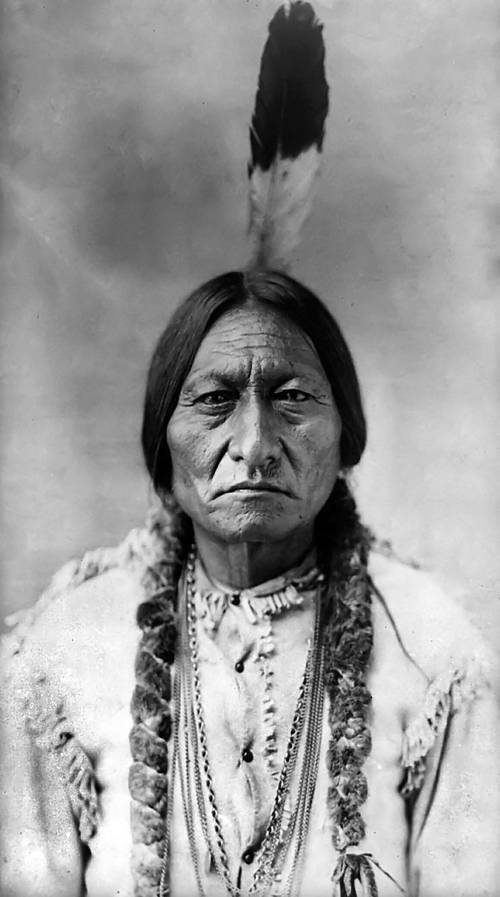
FAQ About Sitting Bull

Who was Sitting Bull?
Sitting Bull was a renowned Hunkpapa Lakota leader and one of the most prominent figures in Native American history. He is best known for his role in resisting the United States government's policies and for his leadership in the Battle of the Little Bighorn in 1876. Sitting Bull was a symbol of Native American resistance and a revered leader among his people.

What is the significance of the Battle of the Little Bighorn?
The Battle of the Little Bighorn, also known as Custer's Last Stand, was a significant conflict that took place on June 25-26, 1876. It was a battle between the combined forces of the Lakota, Northern Cheyenne, and Arapaho tribes against the 7th Cavalry Regiment of the United States Army, led by Lieutenant Colonel George Armstrong Custer. The battle resulted in a decisive victory for the Native American forces, and it is considered a major symbol of Native American resistance against U.S. expansion.

How did Sitting Bull become a leader?
Sitting Bull rose to leadership through his courage, wisdom, and ability in battle. He was recognized early in his life for his bravery in confrontations with enemy tribes and was given the name "Sitting Bull" for his steadfastness and ability to remain resolute. As a result of his skills and his ability to inspire others, he became a leader of the Hunkpapa Lakota at a young age, eventually uniting many of the Lakota bands under his leadership during crucial moments of resistance.

What role did Sitting Bull play in the Indian Wars?
Sitting Bull played a pivotal role in the Indian Wars, particularly in uniting the Plains tribes to resist U.S. government encroachments on their lands. He was a spiritual leader and strategist who strongly opposed the treaties imposed by the government that often violated Native American rights and sovereignty. His leadership was influential in the collective resistance that led to the victory at the Battle of the Little Bighorn.

What happened to Sitting Bull after the Battle of the Little Bighorn?
After the Battle of the Little Bighorn, Sitting Bull and his followers faced increased pressure from U.S. military forces. To avoid further conflict, he fled north to Canada in 1877, where he remained for several years. In 1881, Sitting Bull returned to the United States and eventually surrendered to U.S. forces. He was later held prisoner but was eventually allowed to join Buffalo Bill's Wild West Show, where he gained fame as a performer representing Native American culture.

What were Sitting Bull's views on treaties with the U.S. government?
Sitting Bull was a staunch opponent of the treaties offered by the U.S. government, as he saw them as unjust and detrimental to Native American sovereignty and way of life. He famously refused to sign the Treaty of Fort Laramie in 1868, which aimed to establish peace in the region by ceding large portions of Native land to the U.S. Sitting Bull believed that the land was sacred and belonged to his people, and he consistently advocated for the preservation of Native lands and independence.

How did Sitting Bull die?
Sitting Bull died on December 15, 1890, during an attempt by U.S. Indian police to arrest him at the Standing Rock Indian Reservation in South Dakota. The arrest was part of a broader effort to quell the Ghost Dance movement, which the U.S. government viewed as a potential uprising. During the arrest, a skirmish broke out, and Sitting Bull was shot and killed.

Did Sitting Bull ever travel outside the United States?
Yes, Sitting Bull traveled outside the United States during his time in Canada, where he sought refuge from 1877 to 1881 in what is now Saskatchewan. He lived among the Lakota and other Indigenous groups in Canada, maintaining a life away from U.S. government authorities. His time in Canada was marked by his attempts to sustain his people's way of life despite the challenges.

Why is Sitting Bull considered a symbol of Native American resistance?
Sitting Bull is considered a symbol of Native American resistance due to his unwavering stance against U.S. efforts to subjugate and displace Native American tribes. He consistently fought against treaties that he saw as oppressive and was determined to preserve the Lakota way of life. His leadership during the Battle of the Little Bighorn and his refusal to cede to government demands solidified his status as a symbol of resilience and resistance.

What was Sitting Bull's role in the Ghost Dance movement?
Sitting Bull's involvement in the Ghost Dance movement, a religious movement that sought to restore Native American lands and way of life through a communal dance, was significant as a spiritual leader. Although Sitting Bull himself was somewhat skeptical of the movement, he supported its practice among his people as a means of cultural expression and spiritual hope. However, the U.S. government viewed the movement as a threat, which ultimately led to increased tensions that resulted in his death.

Did Sitting Bull ever work in a Wild West Show?
Yes, Sitting Bull was part of Buffalo Bill Cody's Wild West Show from 1885 to 1886. During his time in the show, Sitting Bull traveled across the United States and even visited parts of Canada. Despite the commercial nature of the show, Sitting Bull utilized the opportunity to educate audiences about the Lakota people and raise awareness about their situation. He also earned money during his participation, which he often used to support his people.

What was Sitting Bull's early life like?
Sitting Bull was born around 1831 near the confluence of the Grand and Missouri Rivers, in present-day South Dakota. As a child, he was known by the name Jumping Badger and demonstrated bravery from a young age. His early life was defined by traditional Lakota customs and values, and he quickly became known for his prowess as a hunter and warrior, eventually earning the name "Sitting Bull" for his tenacity and composure in battle.

How did Sitting Bull's leadership style impact his people?
Sitting Bull's leadership style was characterized by his ability to unite disparate groups and inspire through his spiritual and tactical guidance. He empowered his people by encouraging resistance to unfair treaties and promoting Lakota culture and traditions. His emphasis on unity and strategic thinking was crucial in maintaining the morale and structure necessary for his people to resist displacement and cultural erosion effectively.

What was the significance of Sitting Bull's vision before the Battle of the Little Bighorn?
Before the Battle of the Little Bighorn, Sitting Bull had a vision during a Sun Dance ceremony in which he saw soldiers falling into the Lakota camp "like grasshoppers from the sky." This vision was interpreted as a prophecy of victory over the U.S. military forces. His vision boosted the morale of the warriors and was seen as a spiritual affirmation of their cause, contributing to their determination in the battle that followed.

What was Sitting Bull's heritage and tribal affiliation?
Sitting Bull was a member of the Hunkpapa Lakota Sioux tribe. The Lakota are one of the three major divisions of the Sioux nation, known for their rich cultural heritage and warrior tradition. Sitting Bull's heritage played a significant role in his identity and leadership style, as he was deeply committed to the values and traditions of his people, and he sought to protect their land and way of life from encroachment.

What role did Sitting Bull play in negotiations with the U.S. government?
Sitting Bull was known for his staunch opposition to negotiating with the U.S. government, particularly when it came to ceding lands or compromising the sovereignty of his people. Unlike some other leaders who considered negotiation, Sitting Bull remained firm in his resistance, seeing such treaties as one-sided. His leadership embodied a non-compromising stance on Native American rights and independence.

How is Sitting Bull remembered today?
Today, Sitting Bull is remembered as a legendary leader and a symbol of Native American resistance and dignity. His life and actions have been extensively studied in history, and he has been depicted in various cultural works, highlighting his role in the struggle for Native American sovereignty and cultural preservation. Monuments and museums commemorate his legacy, and his leadership remains a source of inspiration for many.

Where is Sitting Bull buried?
Sitting Bull was originally buried at Fort Yates in North Dakota. However, in 1953, some of his supporters exhumed his remains and moved them near his birthplace at Mobridge, South Dakota, to honor him and be closer to the land he was deeply connected to. This relocation is reflective of the respect and reverence many still hold for his legacy.

Did Sitting Bull have any descendants?
Yes, Sitting Bull had several children and descendants who survived him. His family lineage continues today, and many of his descendants play active roles in preserving his legacy and promoting Native American rights and history. The Sitting Bull College and other initiatives work towards preserving his cultural impact through education and community outreach.

How did Sitting Bull's resistance influence other Native American leaders?
Sitting Bull's steadfast resistance and leadership deeply inspired other Native American leaders and communities. His actions demonstrated the power of unity and non-violent resistance against oppressive policies and served as a beacon for preserving indigenous cultures in the face of adversity. Many leaders from different tribes looked up to Sitting Bull's strategies and moral courage as an exemplar for their resistance efforts.
